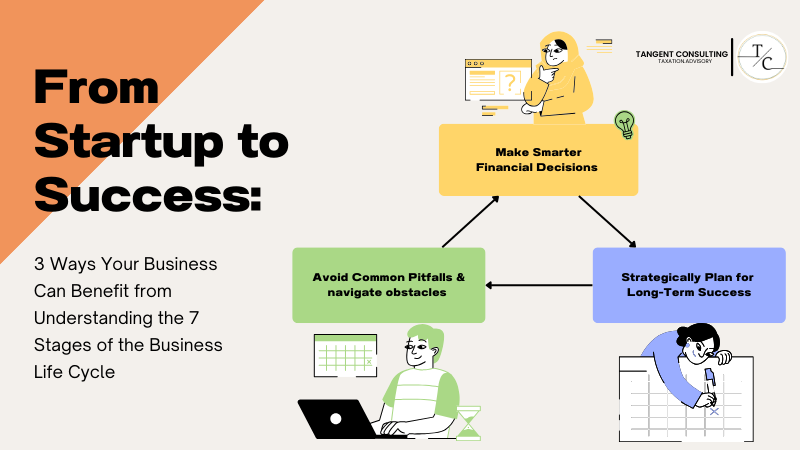7 stages of the business life cycle in order

When Breaking Bad started, Walter White was just a high school chemistry teacher struggling with bills. By the final season, he was running an empire (for better or worse). The transformation didn’t happen overnight; it followed a certain process.
Businesses are the same way. They start small, fight for survival, grow, scale, and become big or lose everything.
If you are looking to start a business, you need to know the 7 stages of the business life cycle in order. These stages can help you create a storyline for your business from start to finish. So, let’s break it down!

What is the Business Life Cycle?
The business life cycle represents any business’s journey from an idea to an exit. As we’ll discuss later, each stage of this cycle comes with its set of challenges, risks, and growth opportunities. Some businesses pass through these phases easily, while others struggle.
Take Airbnb, for instance. It started as an idea in 2007 when two guys rented out an air mattress in their apartment to make extra cash. That was its seed stage. As they gained momentum, they built a platform and secured funding (startup stage). Over time, they fine-tuned operations, expanded globally, and became a household name (growth and expansion stages). Today, Airbnb is a public company.
What Are the 7 Stages of the Business Life Cycle in Order?
According to the US Bureau of Labor Statistics, 1 in 4 businesses fail within one year. But why do so many businesses struggle?
The biggest reason is many entrepreneurs don’t understand the business life cycle, how their company evolves, what challenges lie ahead, and how to navigate each stage strategically.
So, let’s break down 7 stages of the business life cycle in order.
1. The Seed Stage
This is where it all begins. You’ve got a business idea. But before you start, you need to validate your idea. At this stage, many entrepreneurs make the mistake of chasing too many opportunities at once. Instead of trying to do everything, focus on one solid opportunity and test whether the market actually wants it.
What Should You Focus On?
- Skills Check: Does your idea align with your expertise, experience, and passion? Running a business takes grit, so make sure you love what you’re about to build.
- Ownership Structure: Decide if you’re flying solo, forming a partnership, or creating an LLC/corporation. This will impact everything from taxes to liability.
- Business Plan: Map out the who, what, and how—who your customers are, what problem you’re solving, and how you’ll make money.
- Funding: Unless you’re sitting on piles of cash, you’ll need money. Options include:
Self Funding
Friends and family investments
Government grants or small business loans
Crowdfunding or angel investors
The seed stage is all about validation. Before you pour your life savings into the business, test the waters. Get feedback, refine your idea, and make sure it’s something people want.

2. The Start-Up Stage
Your business is officially a thing, and now it’s time to prove that your idea isn’t just good on paper but works in the market. This stage is all about execution, survival, and adaptation.
But here’s the catch: everything takes longer and costs more than you expect. You’ll need to fine-tune your product or service, attract your first paying customers, and start building a market presence. This is where many businesses struggle because they either burn through cash too fast or realize their initial strategy needs tweaking.
Key Priorities in the Start-Up Stage:
- Deliver on Your Promise: Make sure your product or service is ready for real customers.
- Find Your First Customers: Your goal isn’t just selling; it’s about learning.
- Market Presence: Start positioning your brand. Whether it’s social media, SEO, or networking, make sure people know you exist.
- Financial Survival: Keep your expenses lean—fancy offices and big marketing budgets can wait. If your costs are higher than expected, adjust your pricing or business strategy. Raise more cash only if necessary.

3. The Growth Stage
You’ve made it past the rocky start-up stage. Your business is no longer just an idea; it’s a legitimate operation with a growing customer base and steady revenue. This is where you start seeing real profits, but guess what? So does your competition.
How to Manage Growth?
Refine Your Business Model: What worked in the start-up phase won’t necessarily work now. Adapt your strategies to support expansion.
Hire Smart: You need people who can help manage the workload, not just warm bodies to fill roles. Hiring the right team is key to sustainable growth.
Improve Financial and Operational Systems: Get serious about accounting, cash flow management, and automation. Consider upgrading to more robust accounting software and streamlining workflows to avoid bottlenecks.
4. The Established Stage
You’re no longer the start-up fighting for survival. Your business is self-sustaining, profitable, and well-known in your market. Customers know your brand, revenue is flowing, and operations are running smoothly. Sounds like a dream, right?
Well, here’s the catch: Complacency is the silent killer of established businesses.
Many companies hit a plateau at this stage. The growth is stable, but it’s easy to slip into maintenance mode—and that’s when competitors creep in and customers need to shift.
How to Stay on Top?
Keep Up with Industry Trends: Markets shift. Customers change. If you’re not paying attention, you’ll wake up one day and realize you’ve been left behind. Stay ahead by continuously learning, adapting, and innovating.
Expand or Diversify: Consider new product lines services, or even entering new markets to keep the momentum going.
Customer Retention Over Acquisition: At this stage, loyal customers are your biggest asset. Strengthen relationships, improve service, and keep them engaged.
Optimize, Optimize, Optimize: Streamline operations, cut unnecessary costs, and reinvest in smarter technology to boost efficiency.

5. The Expansion Stage
Your business is growing, sales are steady, and you’ve built a strong reputation. But now, you’re facing a new challenge—growth has slowed or even plateaued. You can either stay comfortable or expand into new markets and unlock fresh opportunities.
Expansion sounds exciting, but it’s risky. Jumping into a larger, more competitive market can drain your resources fast if you don’t plan strategically.
How to Expand the Smart Way?
Market Research: Don’t assume new customers will flock to you just because your original business is doing well. Study the demand, competition, and potential roadblocks before making a move.
Go Where Your Strengths Are: Expanding into a market related to your existing business reduces risk and increases the chances of success.
Test Before Going All In: Consider a soft launch, a pilot program, or a small-scale expansion before making heavy investments.
Scale Systems and Resources: Expansion means more customers, more demand, and more moving parts. Make sure your operations, finances, and team can handle the growth.
6. The Decline Stage
This is the stage no business owner wants to face—but it happens more often than you’d think. Sales start dipping, profits shrink, and cash flow dries up. If nothing changes, the business either gets sold, shuts down, or becomes irrelevant.
Many companies reinvent themselves at this stage, finding new ways to stay relevant, pivot, or expand into new markets. Others ignore the warning signs and lose their business.

7. The Exit Stage
After years of grinding, growing, and overcoming challenges, you’ve reached the final stage: exiting the business. However, for successful businesses, this is a golden opportunity to sell at a premium and walk away with a well-earned payday. For struggling businesses, it’s about damage control, minimizing losses, and navigating bankruptcy if necessary.
Final Thoughts
Business is a game of adaptation. No company stays in the same stage forever. Things evolve, challenges shift, and new opportunities arise. The key to long-term success is knowing where you are in the business life cycle and staying ahead of the curve.
So, ask yourself: Which stage is your business in right now? And more importantly, if you aren’t sure, you can always consult. Fortunately, you don’t have to open a new tab to get professional help.
Tangent Consulting has years of experience as a CFO, business coach, and tax consultant. With us, you don’t need to hire an accountant or business coach separately; you can get both in one place.
P.S. If you are reading this, it means you can have access to our free consultation for your business. Avail this for free today before we change our mind 😉
FAQs
How many stages of growth are there?
There are four main stages of business growth: Startup, Growth, Maturity, and Renewal or Decline. Businesses progress through these stages as they expand, refine operations, and adapt to market demands.
What is a business outline?
A business outline is a structured plan that details the key components of a business, including its mission, goals, target market, products/services, operations, marketing strategy, and financial projections.
What are the 7 P’s of business level?
The 7 P’s of business, also known as the Marketing Mix, are:
- Product
- Price
- Place
- Promotion
- People
- Process
- Physical Evidence
